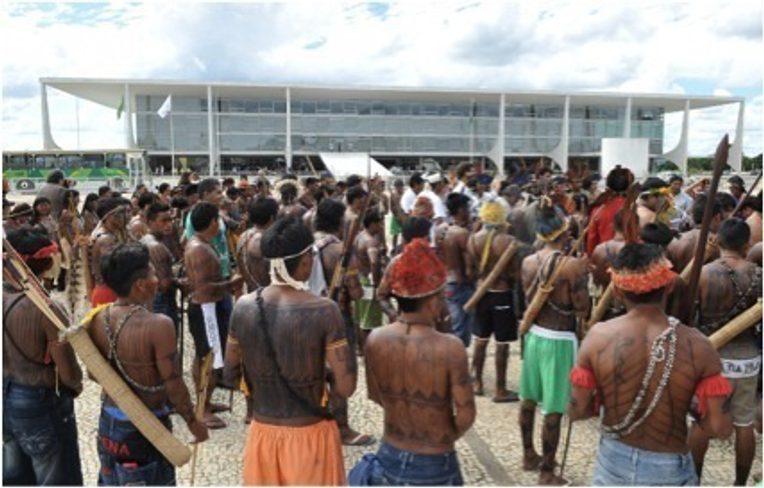The Indians Who Never Slept: The Indigenous from Tocantins (North Of Brazil) and the Protests of June
From the Series: Protesting Democracy in Brazil
From the Series: Protesting Democracy in Brazil

The phrase “the Giant’s waked up,” broadly used in the social networks to define the protests in Brazil in last June, is not appropriate, we believe, to the Brazilian indigenous people or their representative movements. In recent Brazilian history, the indigenous movement’s articulations gained strength by the end of the 1970s, a period during which the so-called “new social movements in Brazil” stand out.
The paths that led to the guarantees of the Indians’ rights to their cultural preservation and their land demarcation, in the specific case of the Brazilian indigenous populations, involved a tense debate between the ones who defended an integrationist project and the defenders of the traditional rights of these people to their cultural identity. The defense of the indigenous rights as natives, we mean, previous to the National Constitution, crashed into the bill that aimed to emancipate the so-called civilized Indians, proposition of the Minister of Interior in 1978, ten years before the current Constitution´s promulgation. In short, “to emancipate,” according to Cunha (2009), meant to revoke the right of those fellows to be “legally Indians,” and, as a consequence, the right to the land they traditionally occupied. The mobilization against the emancipation made by indigenous people’s defense entities, indigenous leaderships and the Brazilian Anthropology Association promoted a strong articulation and debates around the Indians’-rights guarantees, whose success may be certified at Constitution—Chapter 231, which is about the inalienable right of the indigenous peoples to their land and ethnic identity: “The Indians social organization, habits, languages, beliefs and traditions are recognized, beyond their native rights upon the land which they traditionally occupy, coming within the competence of the Union to demarcate them, to protect and to assure respect to all their goods.”
In the state of Tocantins, the history of the public policies’ development is associated to its own history, and, in earlier research, we identified that it’s also interspersed by representations that are not related to the indigenous reality, marked by romanticism and exoticism (Silva 2001). The assistance to the state’s indigenous people, previously centralized by the Indians’ National Foundation, within a restructuring process, is currently diluted in inefficient and low-consequence policies. The abandonment of the indigenous people to their own fate, besides the attempts to make the laws that guarantee the protection of their land flexible, have caused vigorous reactions over the last ten years. The biggest offensive against indigenous rights is observed in Brazil since the promulgation of its Constitution in 1988. A huge mobilization of the indigenous movement takes place in the last three years: public buildings invaded, employees of entities taken as hostages, manifestations in Brasília, road blockades, hydroelectric plants site occupations, and efforts to obtain the society support through the social networks. Many Facebook users in Brazil have recently added the surname Guarani-Kaiowa to their profile in reference to the violence of farmers against the rights of this people living in the state of Mato Grosso, in the country’s west-central region. In Tocantins, a state in the north region where seven indigenous peoples live, the unanimous demand is for health assistance. In the period from May 22 to 25, about a month before the protests in Brazil, the II Meeting of Indigenous People from Goiás and Tocantins was organized by the Indigenous Missionary Counsel, where issues like the indigenous health assistance, their land protection/demarcation, and education were to be discussed. This meeting was carried out in Palmas, capital of Tocantins, with the participation of five-hundred representatives of indigenous peoples from both states. It was marked by tense discussions between Indians and representatives of government institutions; for instance, on the second day of the meeting, a group of indigenous women, leaded by Gercília Krahô, became the protagonists of a highly significant event about their position and struggle: they just put the regional coordinator of the Indigenous Health General Office of Tocantins out of the discussion, dismissing her from the office and removing her from the meeting. “We did this because that woman (Ivanezília) lies too much. Don’t you, kupê (white people) do it worse to us? Don’t you expel us from land? Don’t you kill us, leave us die, and rob our resources? We apologize, as we’re not violent. This is not our manner. But not even the big boss from Brasília comes to see us, to listen to us,” she concluded.

Two big protests happened in the two major cities of Tocantins (Araguaína and Palmas) in June. The Indians and their movement didn’t participate. Perhaps that absence says something about the protests and about Brazil, as the long demands list presented by demonstrators didn’t mention, at least in Tocantins, the indigenous rights. Do the protests show the Brazilian face? Do they deal with all the demands and subject matters of the society? We certainly don’t yet have the proper distance (in time) to analyze them with calm and care, but we do can state that a significant sector of Brazilians wasn’t represented and didn’t allow itself to be represented by the ones who woke up on last June. Perhaps because that sector, especially the indigenous people, hasn’t sleep since a long time ago.
Brasil, Republica Federativa do. Constituição da República Federativa Do Brasil. Diário Oficial da União. October 5, 1988.
Cunha, Manuela Carneiro da. 2009. Cultura com aspas e outros ensaios. São Paulo: Cosac Naify.
Nimuendajú, Curt. 1942. The Sherente. Los Angeles: The Southwest Museum.
Ramos, Alcida Rita. 2004. “O pluralismo brasileiro na berlinda.” Série Antropologia, Brasília, no. 353: 1–17.
Silva, Reijane Pinheiro Da. 2010. “O índio negado e o índio desejado: A pacificação dos indígenas na construção da identidade do Tocantins.” Campo Grande: Tellus (UCDB), v. 10, 145–62.